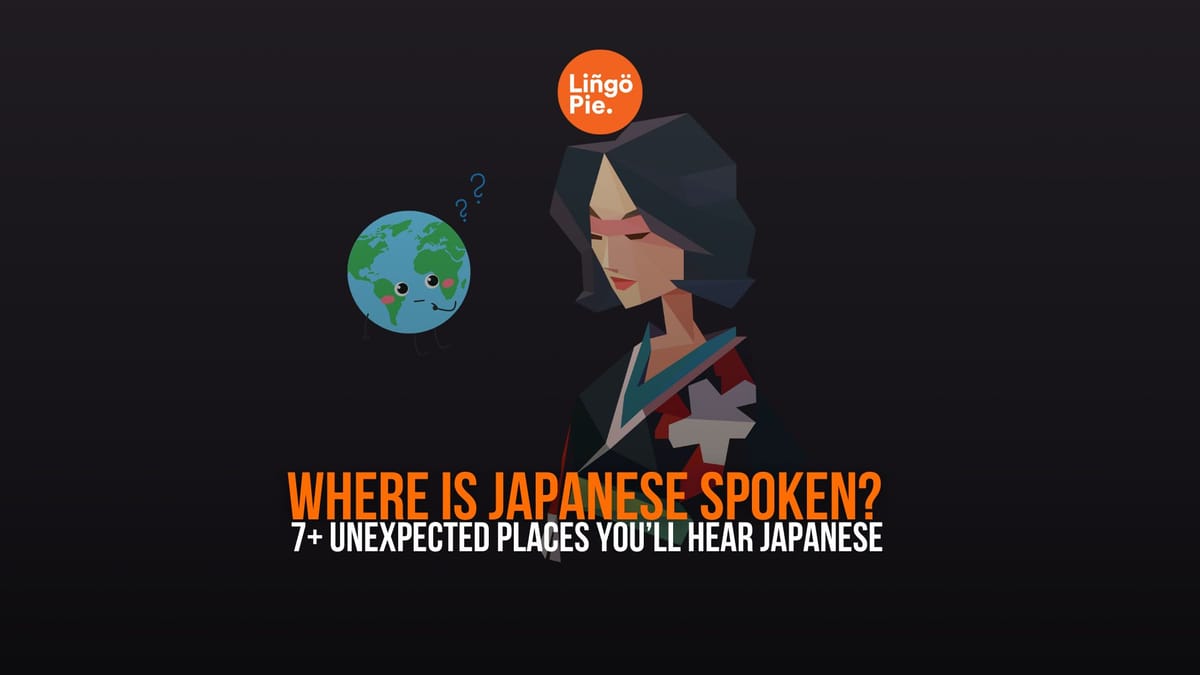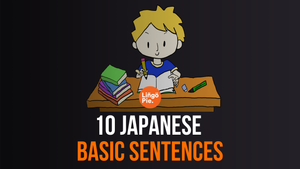The Japanese language, known as Nihongo (日本語), is deeply tied to Japan’s unique culture, history, and national identity. It is spoken by over 125 million people, making it one of the most widely spoken languages in Asia. But is it only spoken in Japan? What about other countries that use, teach, or preserve Japanese? And why is Japanese so widely studied globally despite being tied to just one nation?
In this guide, we take a fresh, global look at the Japanese-speaking world. We go beyond Japan’s borders to explore the presence of Japanese in diaspora communities, diplomatic relations, and language education systems around the globe.
- 22+ Japanese Slang Words That Locals ACTUALLY USE
- 10 Japanese Basic Sentence Patterns For Total Beginners
- 70+ Japanese Anime Phrases Every Fan Heard At Least Once

What Language Do Japanese People Speak?
The primary language spoken by Japanese people is Japanese, a language isolate, which means it has no clear linguistic relatives. Japanese has three writing systems (ひらがな - hiragana, カタカナ - katakana, and 漢字 - kanji) and a unique system of honorifics and levels of politeness.
Japanese is known for:
- Agglutinative grammar, where words are formed by adding suffixes to roots
- Contextual communication, where meaning often relies on social context
- Particles like wa (は), ga (が), ni (に), de (で), which define grammatical relationships
Japan is the sole country where Japanese is the official language. Virtually all of Japan's population (over 125 million people) speaks Japanese as their native language. It is the language of government, education, media, and daily life.
Regional dialects (called hōgengo) exist across Japan, with variations in pronunciation and vocabulary, like Kansai-ben (Osaka) or Tōhoku-ben (Northeast), but standard Japanese (Hyōjungo) is universally taught and understood.
Countries and Regions Where Japanese Is Widely Spoken or Studied
1. Brazil

Brazil has the largest Japanese diaspora in the world, with over 1.5 million people of Japanese descent, according to historical migration data. These communities are largely centered around São Paulo and Paraná, where Japanese Brazilians continue to maintain language and cultural traditions through local schools, newspapers, religious institutions, and events such as the Festival do Japão.
Although younger generations are more likely to speak Portuguese as their first language, many still study Japanese through private schools or community programs. According to the Japan Foundation, approximately 20,000 people in Brazil were studying Japanese in 2021, making it one of the largest Japanese-learning populations outside Asia.
2. United States

The U.S. is home to a sizable Japanese-American population, with approximately 1.5 million people of Japanese descent, particularly concentrated in Hawaii and California. Japanese was introduced to Hawaii in the late 19th century during waves of labor migration, and remnants of that linguistic legacy remain. In Hawaii, Japanese is still offered in public and private schools, and cultural festivals often feature Japanese-language signage and performances.
Nationwide, Japanese ranks among the top five most studied foreign languages. The Japan Foundation reported over 160,000 Japanese language learners in the U.S. in 2021. A significant portion of this population consists of high school and university students interested in anime, manga, technology, or Japanese business and academic exchange opportunities.
3. Taiwan

Taiwan holds a special place in the Japanese-speaking world due to historical colonization. From 1895 to 1945, Taiwan was a colony of Japan, and during this period, Japanese was the language of government and education. As a result, many elderly Taiwanese still speak fluent Japanese and retain cultural ties to Japan.
Today, over 260,000 students in Taiwan are learning Japanese, making it one of the top 10 countries globally in terms of Japanese learners per capita. The language is widely taught in schools, universities, and cultural institutions. Japan is Taiwan’s third-largest trading partner, further motivating language study for business and travel.
4. Korea (South Korea)

South Korea has over 900,000 Japanese language learners, making it one of the most significant Japanese-learning nations globally. This popularity is partially rooted in geographic proximity and long-standing economic ties between the two countries.
Japanese is commonly offered as a second or third language in South Korean middle schools, high schools, and universities. Additionally, Korean students and young professionals often study Japanese to pursue jobs in Japan or with Japanese companies operating in South Korea. Cultural motivations also play a role, as many Koreans enjoy Japanese media, literature, and fashion.
5. Philippines

In the Philippines, Japanese is a strategic language for employment and overseas migration. Tens of thousands of Filipinos work in Japan each year through government-sponsored training programs and technical internships. To prepare, many undergo Japanese language training through TESDA (Technical Education and Skills Development Authority) programs or Japanese-run language centers.
As of 2021, there were over 58,000 active Japanese learners in the Philippines. While the majority learn for work-related reasons, there is also a growing interest in Japanese culture, particularly anime and pop music, among younger Filipinos.
6. China

China boasts the largest number of Japanese learners in the world, with more than 700,000 students actively studying the language. Japanese is a standard foreign language option in many Chinese high schools and universities, particularly in urban centers like Beijing, Shanghai, and Guangzhou.
Beyond the classroom, Japanese is studied for its practical value in business, international trade, and cultural exchange. Japan remains one of China’s major trade partners, and fluency in Japanese is a valuable asset for Chinese professionals working in manufacturing, logistics, and translation sectors.
7. Australia

Australia has long embraced Japanese as a key foreign language in its education system. Japanese is taught in primary and secondary schools across most Australian states, and it is the most studied foreign language in the country, with around 200,000 students.
Australia’s geographic location in the Asia-Pacific region, strong tourism links, and vibrant bilateral trade make Japanese a practical and popular choice. Major cities like Sydney, Melbourne, and Brisbane host annual Japanese festivals and are home to Japanese cultural centers, reinforcing the language’s visibility.
8. Other Global Communities
Several other countries have growing Japanese-speaking or Japanese-learning populations:
- Canada: Over 27,000 students study Japanese, supported by strong university programs and cultural festivals.
- Vietnam: With over 170,000 Japanese learners, Vietnam’s relationship with Japan is largely driven by work-study and technical intern exchange programs.
- Indonesia: Another Southeast Asian nation with 170,000+ students, benefiting from Japanese business investment and education partnerships.
- France, Germany, UK: Each has between 10,000 and 30,000 active Japanese learners, often drawn to the language through pop culture, tourism, or university studies.
Together, these regions represent a diverse tapestry of Japanese language presence—from heritage preservation in Latin America to strategic education in Asia and growing curiosity in the West.
Why Is Japanese Spoken In These Countries?
1. Cultural Soft Power (Pop Culture & Media)
Japanese anime, manga, music, fashion, and food have fueled international fascination. The global anime market alone surpassed $24 billion in 2023 (Statista), contributing significantly to Japanese language interest.
Language learners often cite the desire to understand untranslated content or connect with creators directly. Platforms like YouTube, Netflix, and Crunchyroll provide abundant Japanese content with subtitles.
2. Economic Influence
Japan is the third-largest economy globally (IMF, 2023), home to leading companies in tech, automotive, and finance. Japanese proficiency offers a competitive edge in global business, especially in:
- Manufacturing and engineering
- IT and game development
- Trade and diplomacy
Programs like JET (Japan Exchange and Teaching Programme) also offer incentives for foreigners to teach English in Japan while learning the language.
3. Diaspora Maintenance
Descendants of Japanese immigrants, especially in Brazil, Peru, and the U.S., maintain Japanese through community schools, media, and religion (such as Japanese-language Buddhist temples).
4. Education Infrastructure
Institutions like the Japan Foundation, JLPT (Japanese-Language Proficiency Test), and local language schools help structure and grow Japanese language education.
Learn Japanese with Lingopie
What if you could learn Japanese just by watching your favorite anime? With Lingopie, you can binge your favorite anime, catch up on J-Dramas, and actually build real fluency at the same time.
Every show comes with interactive dual subtitles that let you click and save new words instantly. You’ll hear how Japanese really sounds and pick up grammar naturally through stories you're already hooked on. It's language learning that doesn't feel like studying!
Want to test it out? Give Lingopie a try now by signing up below for a FREE 7-day trial!





![How To Use Mo (も) Particle In Japanese Grammar [Guide]](/blog/content/images/size/w300/2025/06/How-To-Use-Mo-----Particle-In-Japanese-Grammar.jpg)


